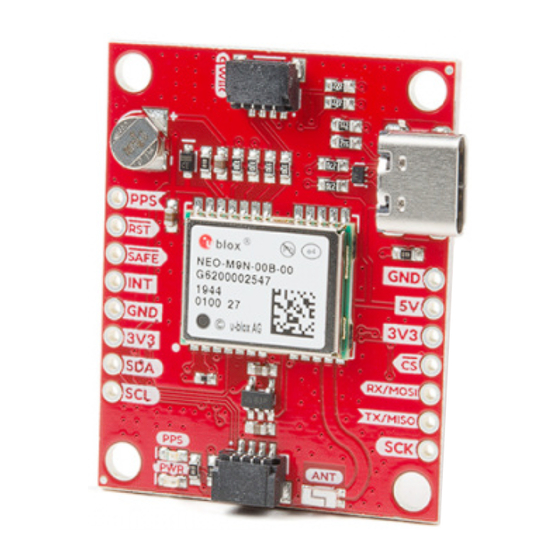
Advertisement
Quick Links
SparkFun GPS NEO-M9N Hookup Guide
Introduction
The SparkFun GPS NEO-M9N is the next iteration of u-blox's GPS offerings! We've developed two flavors of the
board: one with a small chip antenna and another with a u.FL connector so that you can select an antenna of your
choosing.
SparkFun GPS Breakout - NEO-M9N, Chip Antenna
(Qwiic)
GPS-15733
Advertisement

Subscribe to Our Youtube Channel
Summary of Contents for sparkfun NEO-M9N
- Page 1 Introduction The SparkFun GPS NEO-M9N is the next iteration of u-blox's GPS offerings! We've developed two flavors of the board: one with a small chip antenna and another with a u.FL connector so that you can select an antenna of your choosing.
- Page 2 SparkFun GPS Breakout - NEO-M9N, U.FL (Qwiic) GPS-15712 Product Showcase: SparkFun GPS Breakout NEO-M Product Showcase: SparkFun GPS Breakout NEO-M… … Required Materials To follow along with this tutorial, you will need the following materials. You may not need everything though...
- Page 3 GNSS Antenna Evalutation Board listed below and make sure to get the u.FL to u.FL connector in the accessories. GPS/GNSS Magnetic Mount Antenna - 3m GPS/GNSS Embedded Antenna - 1m (SMA) (SMA) GPS-14987 GPS-14986 SparkFun GNSS Chip Antenna Evaluation GPS Embedded Antenna SMA Board GPS-00177...
- Page 4 GPS Antenna Accessories Interface Cable SMA to U.FL GPS Antenna Ground Plate WRL-09145 GPS-15004 U.FL to U.FL Mini Coax Cable - 200mm WRL-15114 Other Qwiic Cable Accessories SparkFun Qwiic Cable Kit Qwiic Cable - 100mm KIT-15081 PRT-14427...
- Page 5 PRT-14426 Heads up! If you are using the RedBoard without a Qwiic connector, we recommend getting the Qwiic Shield for Arduino. SparkFun Qwiic Shield for Arduino DEV-14352 Suggested Reading If you aren't familiar with the Qwiic system, we recommend reading here for an overview.
-
Page 6: Hardware Overview
GPS Basics Serial Peripheral Interface (SPI) The Global Positioning System (GPS) is an SPI is commonly used to connect microcontrollers to engineering marvel that we all have access to for a peripherals such as sensors, shift registers, and SD relatively low cost and no subscription fee. With the cards. - Page 7 Battery The small metal disk in the upper left corner is a small lithium battery. This battery does not provide power to the IC like the 3.3V system does, but to relevant systems inside the IC that allow for a quick reconnection to satellites. The time to first fix will about ~29 seconds, but after it has a lock, that battery will allow for a two second time to first fix.
- Page 8 UART functions on those lines. For more information, check out our tutorial on working with jumper pads and PCB traces. Chip Antenna or U.FL Connector The SparkFun GPS NEO-M9N with Chip Antenna has a GNSS antenna near its left Qwiic connector while its cousin has a U.FL connector in which you can connect a patch antenna.
- Page 9 Chip Antenna U.FL Qwiic and I C There are two pins labeled which indicates the I C data lines. Similarly, you can use either of the Qwiic connectors to provide power and utilize I C. The Qwiic ecosystem is made for fast prototyping by removing the need for soldering.
- Page 10 UART There are two pins on the right most header labeled for their UART functionality. Broken Out Pins There are four other pins broken out: Pulse per second ( ), Reset ( ), Safeboot ( ), and finally the SAFE interrupt pin ( ).
- Page 11 GPS Capabilities The SparkFun NEO-M9N is able to connect to up to four different GNSS constellations at a time making it very accurate for its size. Below are the listed capabilities of the GPS unit when connecting to multiple GNSS constellations and when connecting to a single constellation.
-
Page 12: Hardware Assembly
Update Rate Time-To-First- Cold Start Hot Start Sensitivity Tracking and -167dBm -167dBm -167dBm -1667dBm Navigation Reacquisition -160dBm -160dBm -160dBm -160dBm Cold Start -148dBm -148dBm -148dBm -148dBm Hot Start -159dBm -159dBm -159dBm -159dBm Velocity 0.05m/s 0.05m/s 0.05m/s 0.05m/s Accuracy Heading 0.3deg 0.3deg 0.3deg 0.3deg... -
Page 13: Example Code
For this example, I used a Qwiic capable RedBoard and associated USB cable. connecting the boards with Qwiic cable, the assembly is very simple. Plug a Qwiic cable between the RedBoard and the SparkFun NEO-M9N with chip antenna and that's it! Just as easily I could have used the version with the U.FL connector and plugged in one of our patch antennas to the GPS board. - Page 14 #include <Wire.h> //Needed for I2C to GPS #include "SparkFun_Ublox_Arduino_Library.h" //Click here to get the library: http://librarymanag er/All#SparkFun_Ublox_GPS SFE_UBLOX_GPS myGPS; void setup() Serial.begin(115200); Serial.println("SparkFun Ublox Example"); Wire.begin(); if (myGPS.begin() == false) Serial.println(F("Ublox GPS not detected at default I2C address. Please check wiring. Freezi ng.")); while (1);...
- Page 15 Are you looking for a GPS receiver with an insane 10mm 3D accuracy, then check out the two other u-Blox based GPS boards by SparkFun (ZED-F9P and NEO-M8P-2) on the left below. Need a smaller more compact GPS unit but don't need as high of a refresh rate, check out the ZOE-M8Q and SAM-M8Q on the right.
- Page 16 SparkFun GPS-RTK Board - NEO-M8P-2 (Qwiic) GPS-15136 GPS-15005 SparkFun GPS Breakout - ZOE-M8Q (Qwiic) SparkFun GPS Breakout - Chip Antenna, SAM- M8Q (Qwiic) GPS-15193 GPS-15210 Need some inspiration for your next project? Check out some of these related tutorials:...
- Page 17 Want to get started in robotics? Look no further than display your GPS coordinates with a press of a button the SparkFun autonomous kit for the Sphero RVR! using hardware from our Qwiic Connect System (I2C). Whether you purchased the Basic or Advanced kit, this...

Need help?
Do you have a question about the NEO-M9N and is the answer not in the manual?
Questions and answers